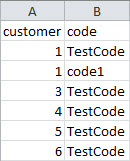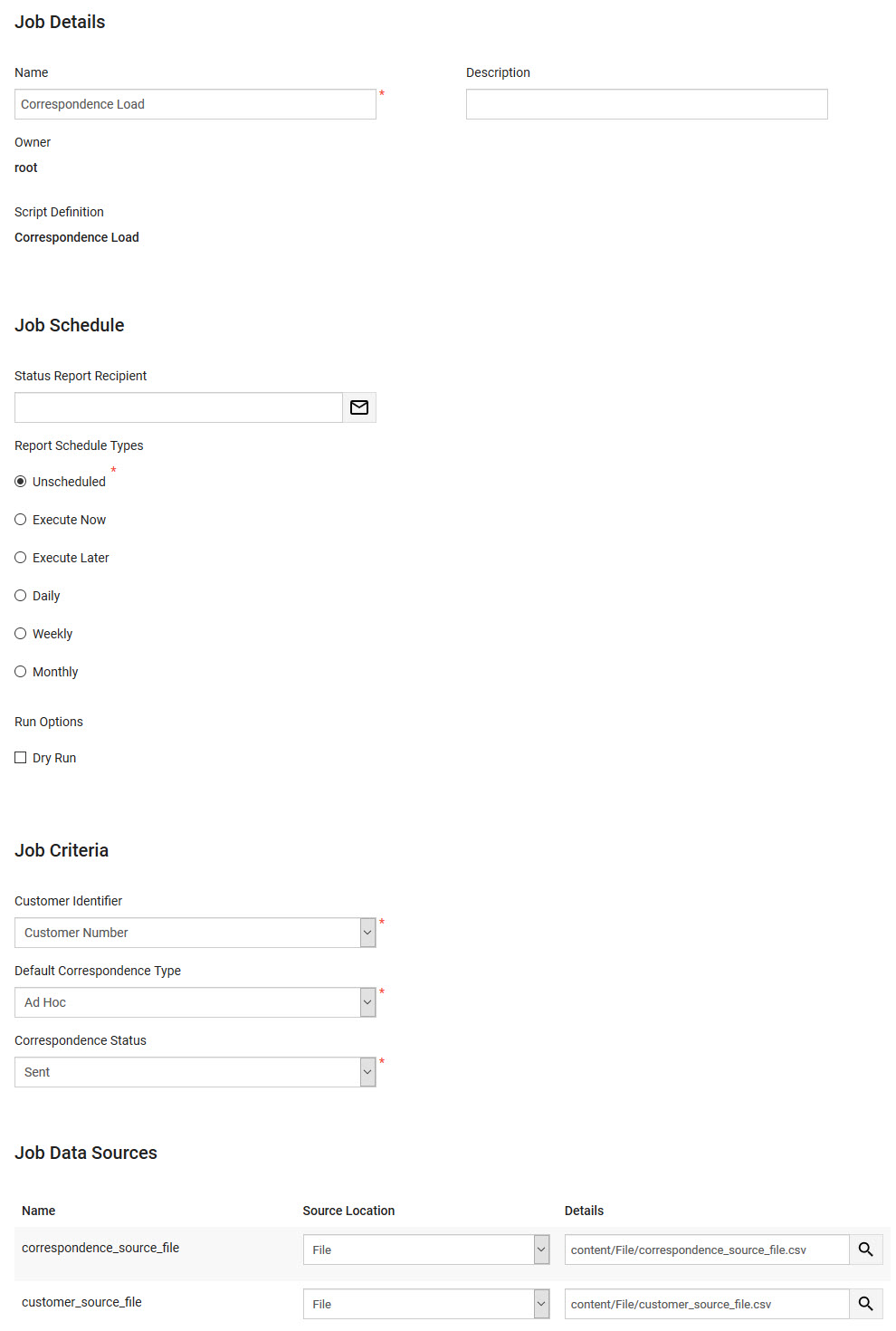•Creating and Executing the Data Management Job
•Data Management Configuration
Summary
Script Name |
Correspondence Load |
Minimum Supported Version |
7.16.0 |
Source Type |
Single Source |
Script Definitions |
Correspondence Load |
Use Case
The Correspondence Load script adds correspondence codes to a set of existing customers, based on two .CSV source files, and data provided in execution fields on the script job.
Configuration Prerequisites
If fields referenced in the script do not have 'Writable' set to Yes, the script will still run successfully but those fields will not be updated. The following table lists the required field configuration for this script to run properly. For more information, refer to Configuring Marketing Data Fields.
Source File Format
The following source files are used with the Correspondence Load script:
correspondence_source_file
The following image illustrates the structure required for the correspondence_source_file source file used for the script:

This is parent source file that contains the correspondence codes and their descriptions.
The following table outlines the field mapping:
Column |
Required? |
Source Column Header |
Field Name |
UI Field Location |
1 |
Yes |
code |
Code (Used as a Source Key Column) |
Customer Services - Customer|Activities page |
2 |
No |
description |
Description |
Customer Services - Customer|Activities page |
customer_source_file
The following image illustrates the structure required for the customer_source_file source file used for the script:

The following table outlines the field mapping:
Column |
Required? |
Source Column Header |
Field Name |
UI Field Location |
1 |
Yes |
customer |
Customer Number (Used as a 'Source Key' column and the customer that the correspondence will be added to.) |
Customer Services - Customer|Basic page |
2 |
Yes |
code |
Code (Used as the 'Parent Key' column to link to the correspondence_source_file) |
Customer Services - Customer|Activities page |
How the Script Works
The following table outlines the actions and the expected resutls of the script:
Condition |
Action |
Expected Results |
Various values that can be provided in the correspondence_source_file are 'description', 'type' (if not present use the one provided in the execution field section) and 'send_date'(if it is not presently set to the current date and time). |
The values provided in source file will be set accordingly. |
Provided values should be set for the correspondence. |
The 'Default Correspondence Type' and 'Correspondence Status' execution fields are used to set the type and status for the correspondence being added. |
If the Default Correspondence Type' is not provided in the source file, the value in execution field will be used. |
Both execution fields set the values for correspondence. |
The 'Customer Identifier' execution field is used to define which value is used to search for the customer (either 'Customer Number', 'Customer ID' or one of the three 'Legacy Account Number' fields) . |
The value selected in the execution field will define what should be provided in customer_source_file map to.
If a customer in the customer_source_file cannot be found, or if a correspondence code in the customer_source_file is not defined in the correspondence_source_file, the record will fail silently (no error will be logged). |
If the execution field has value 'Legacy Account Number 2' then customer values provided in the source file are assumed to be 'Legacy Account Number 2'. All of the customers that match the provided 'Legacy Account Number 2' will have a correspondence code added. |
The contact and address information on the correspondence will be the same as the default for that customer. The source file does not need to provide these fields.
Creating and Executing the Data Management Job
Script Definition Configuration
The following tables outline the script definition configuration:
•Script Definition Name: Correspondence Load
•Application Script: Correspondence Load (text/plain)
Source Section |
||||
Source Name |
Source Type |
Source Key Column |
Parent Source Name |
Parent Key Column |
correspondence_source_file |
Comma Separated Values |
code |
None |
None |
customer_source_file |
Comma Separated Values |
customer |
correspondence_source_file |
Code |
Execution Field Section |
||
Row |
Field |
Source Key Column |
1 |
Customer Identifier |
Any value from the customer identifiers list can be used, based on the values in the source file to identify a customer uniquely. The default value is set to Customer Number. |
2 |
Default Correspondence Type |
Name: default_correspondence_type Label: Default Correspondence Type Type: String Subtype: None List: Correspondence Type Max # Values: 1 Default Value: Ad Hoc Group: None Display on New Row: Yes Required: Yes |
3 |
Correspondence Status |
Name: correspondence_status Label: Correspondence Status Type: String Subtype: None List: Correspondence Status Max # Values: 1 Default Value: Sent Group: None Display on New Row: Yes Required: Yes |
Data Management Configuration
The following outlines the data management job configuration:
•Data Management Job Name: Correspondence Load
•Script Definition: Correspondence Load
The following image is an example of the Data Management|Schedule page when creating a job using all of the available source files:
